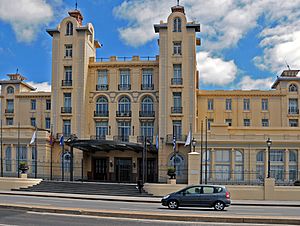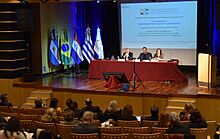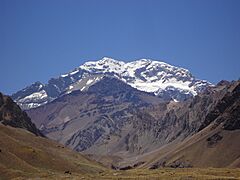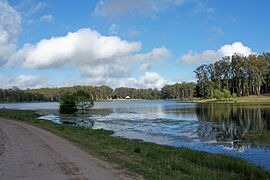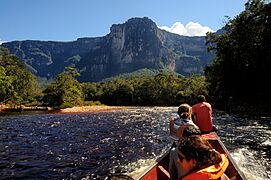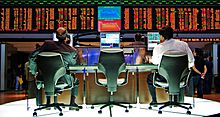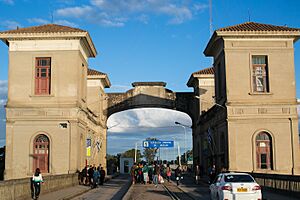Mercosur facts for kids
Quick facts for kids
Southern Common Market
|
|||||||
|---|---|---|---|---|---|---|---|
|
Flag
|
|||||||
|
Motto:
|
|||||||
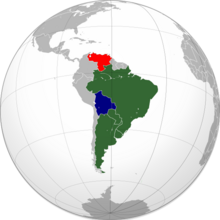
Dark green: full members.
Red: suspended members. Blue: acceding members. |
|||||||
| Headquarters | Montevideo | ||||||
| Largest city | São Paulo | ||||||
| Official languages |
|
||||||
| Type | Intergovernmental organization and customs union | ||||||
| Membership |
1 suspended
2 observers
|
||||||
| Leaders | |||||||
|
• President pro tempore
|
Santiago Peña | ||||||
| Legislature | Parlasur | ||||||
| Formation | |||||||
|
• Iguaçú Declaration
|
30 November 1985 | ||||||
|
• Buenos Aires Act
|
6 July 1990 | ||||||
|
• Treaty of Asunción
|
26 March 1991 | ||||||
|
• Protocol of Ouro Preto
|
16 December 1994 | ||||||
| Area | |||||||
|
• Total
|
11,879,134 km2 (4,586,559 sq mi) (2ndb) | ||||||
|
• Water (%)
|
1.0 | ||||||
| Population | |||||||
|
• 2022 estimate
|
|||||||
|
• Density
|
23/km2 (59.6/sq mi) (204thb) | ||||||
| GDP (PPP) | 2022 estimate | ||||||
|
• Total
|
|||||||
|
• Per capita
|
US$18,987 (78thb) | ||||||
| GDP (nominal) | 2022 estimate | ||||||
|
• Total
|
|||||||
|
• Per capita
|
US$9,643 (79thb) | ||||||
| HDI (2019) | high · 70tha |
||||||
| Currency | |||||||
| Time zone | UTC-2 to UTC-5 | ||||||
| Date format | dd/mm/yyyy (CE) | ||||||
|
|||||||
Mercosur (pronounced Mer-co-SOOR) is a group of South American countries that work together on trade and economic matters. Its full name is the Southern Common Market. It was created in 1991 by the Treaty of Asunción and later updated in 1994 by the Protocol of Ouro Preto.
The main members of Mercosur are Argentina, Brazil, Paraguay, and Uruguay. Venezuela is also a full member, but it has been suspended since December 2016. Other countries like Bolivia, Chile, Colombia, Ecuador, Guyana, Peru, and Suriname are "associate members," meaning they work with Mercosur but aren't full members.
Mercosur helps its member countries trade freely with each other. It also helps people and money move easily between these countries. Since it started, Mercosur has become a customs union. This means that member countries don't charge taxes on goods traded among themselves. They also have a common trade policy for goods coming from outside the group. In 2023, Mercosur was one of the largest economies in the world.
Contents
History of Mercosur
Early Steps Towards Unity
Before South American countries became independent, their trade was mostly controlled by the Spanish Empire. This empire stopped them from trading much with Brazil. In the 1800s, after gaining independence, these countries often had conflicts and even wars.
In 1941, during World War II, Brazil and Argentina tried to create a Customs Union. This plan didn't work out because of different views on global politics. After the war, countries realized they needed to work together. Economic groups started forming around the world.
The Iguaçu Declaration
In December 1985, the presidents of Brazil, José Sarney, and Argentina, Raúl Alfonsín, signed the Iguaçu Declaration. This was a big step towards economic cooperation in the southern part of South America. Both countries had just come out of difficult times and needed to improve their economies.
They both had large debts and needed investments. This shared problem made them realize they could help each other. Soon after, Argentina suggested a "special partnership" with Brazil. They held meetings to discuss how to boost their economies and connect with the rest of the world. This led to the Argentina-Brazil Integration and Economic Cooperation Program (PICE).
The Buenos Aires Agreement
On July 6, 1990, the presidents of Brazil, Fernando Collor de Mello, and Argentina, Carlos Menem, signed the Buenos Aires Act. This agreement aimed for a complete customs union between their two countries by the end of 1994. To make sure this happened, they created a special group to plan how to build this common market.
Later, Paraguay and Uruguay showed interest in joining this plan. This made the original countries realize they needed a bigger agreement that included more nations.
Mercosur is Born
Mercosur was officially created in 1991 with the Treaty of Asunción. This treaty set the rules for a free trade area among Argentina, Brazil, Paraguay, and Uruguay. It also confirmed that the common market should be ready by December 31, 1994. In 2001, to celebrate Mercosur's 10th birthday, its flag was raised for the first time at its main office in Montevideo.
The main goals of this free trade area were:
- Free Movement: Goods, services, and people could move freely between member countries. This meant no customs taxes or other limits on trade.
- Common Tariffs: Member countries would charge the same taxes on imports from countries outside Mercosur. This is called a "common external tariff."
- Fair Treatment: Products made in one member country would be treated the same as products made in another member country.
- Coordinated Policies: Countries would work together on trade, farming, industry, and money policies. This helps ensure fair competition.
The treaty also created two important groups:
- Common Market Group: This group helped solve disagreements and managed the daily work of Mercosur.
- Common Market Council: This was the highest authority, making big political decisions and ensuring deadlines were met.
For a new country to join Mercosur, all current member countries had to approve it.
Venezuela Joins and Paraguay is Suspended

Venezuela started its journey to join Mercosur in 2003. An agreement was signed to slowly reduce trade taxes between Venezuela and Mercosur members. Venezuela became an "associate member" in 2004, meaning it could speak but not vote.
In 2006, all Mercosur presidents signed a document for Venezuela to become a full member. Argentina and Uruguay approved it quickly, but Brazil took until 2009. Paraguay's congress did not approve it, stopping Venezuela from becoming a full member.
However, in June 2012, Paraguay was suspended from Mercosur due to political changes in its government. A month later, the other Mercosur presidents allowed Venezuela to become a full member. This decision was debated. Some thought it would boost Mercosur's economy, while others felt it was too rushed and politically motivated.
Bolivia's Path to Full Membership
On December 7, 2012, Bolivian President Evo Morales signed a document to become a full member of Mercosur. This needed approval from the parliaments of all member countries. By December 2023, all full members had approved Bolivia's request. Now, Bolivia just needs to complete its own internal approval process to become a full member.
Once Bolivia is a full member, it will have four years to change its laws to match Mercosur's rules.
Venezuela's Suspension
In August 2016, the presidents of Brazil, Argentina, and Paraguay met to discuss suspending Venezuela from Mercosur. They were concerned that Venezuela was not following Mercosur's rules for full membership, especially regarding human rights. Venezuela was stopped from taking over the presidency of Mercosur, leading to a disagreement.
On December 1, 2016, Venezuela was officially suspended from Mercosur. This happened after Venezuela was given three months to change its laws to meet Mercosur's requirements for trade, politics, democracy, and human rights.
On August 5, 2017, the foreign ministers of Argentina, Paraguay, Uruguay, and Brazil said that Venezuela's membership was suspended indefinitely. This was because of a "breakdown of democratic order" in Venezuela. Mercosur's rules don't allow for a country to be kicked out, but they can be suspended. Trade and migration policies were kept the same to avoid making the situation worse for people in Venezuela.
In 2019, Mercosur leaders called for "free, fair and transparent presidential elections" in Venezuela. They also expressed worry about the serious crisis in the country, which was affecting people's lives and human rights.
Recent Trade Agreements
In 2023, Brazil's new president, Luiz Inácio Lula da Silva, pushed for new trade agreements between Mercosur and the European Union. Before this, EU officials were hesitant because of concerns about rainforest destruction in the Amazon. At the same time, talks with China and Russia also influenced these trade discussions.
In July 2023, a disagreement arose between Argentina and Paraguay, Bolivia, Uruguay, and Brazil. This was about how freely ships could travel on rivers in the Río de la Plata Basin.
Mercosur's Geography
Mercosur covers a huge area, combining the lands of its member countries in South America. This means it has many different climates, from very cold (like Antarctica) to very hot (tropical). Most people live in areas with a subtropical or tropical climate.
Mercosur countries are home to some amazing natural features:
- The world's highest waterfall, Angel Falls, in Venezuela.
- The largest river by water volume, the Amazon River, in Brazil.
- The longest mountain range, the Andes, with its highest peak, Aconcagua, in Argentina.
- The largest rainforest, the Amazon rainforest, mostly in Brazil.
-
Mount Aconcagua in Argentina
-
The Amazon rainforest in Brazil
-
Gran Chaco in Paraguay
-
The Salto Ángel falls in Venezuela
Some Mercosur members also have claims in Antarctica. Argentina has a claim called Argentine Antarctica, which overlaps with Chile's claim. Brazil doesn't formally claim land but has a "zone of interest" there.
Member Countries
Mercosur has five full member countries: Argentina, Brazil, Paraguay, Uruguay, and Venezuela (though Venezuela is currently suspended). It also has seven associated states: Suriname, Guyana, Colombia, Ecuador, Peru, Chile, and Bolivia (which is becoming a full member). Plus, there are two observer states: Mexico and New Zealand.
After Paraguay's president was removed from office, Paraguay was suspended from Mercosur. Soon after, Venezuela was allowed to become a full member in 2012. Venezuela had four years to follow all of Mercosur's rules but didn't, so it was suspended in December 2016.
| Arms | Flag | Country or territory | Capital | Area | Population (2018) |
Population density |
HDI (2021) |
|---|---|---|---|---|---|---|---|
| Argentina (full member) |
Buenos Aires | 2,766,890 km2 (1,068,300 sq mi) |
44,361,150 | 16.03 per square kilometre (41.5 per square mile) |
0.842 | ||
| Brazil (full member) |
Brasília | 8,514,877 km2 (3,287,612 sq mi) |
209,469,323 | 24.6 per square kilometre (64 per square mile) |
0.754 | ||
| Paraguay (full member) |
Asunción | 406,750 km2 (157,050 sq mi) |
6,956,066 | 17.1 per square kilometre (44 per square mile) |
0.717 | ||
| Uruguay (full member) |
Montevideo | 176,220 km2 (68,040 sq mi) |
3,449,285 | 19.57 per square kilometre (50.7 per square mile) |
0.809 | ||
| Venezuela (suspended member) |
Caracas | 916,445 km2 (353,841 sq mi) |
28,887,118 | 31.52 per square kilometre (81.6 per square mile) |
0.691 | ||
| Bolivia (acceding to full membership) |
La Paz, Sucre |
1,098,580 km2 (424,160 sq mi) |
11,353,142 | 10.3 per square kilometre (27 per square mile) |
0.692 | ||
| Chile (associated member) |
Santiago | 756,950 km2 (292,260 sq mi) |
18,729,160 | 24.74 per square kilometre (64.1 per square mile) |
0.855 | ||
| Colombia (associated member) |
Bogotá | 1,141,748 km2 (440,831 sq mi) |
49,661,048 | 43.49 per square kilometre (112.6 per square mile) |
0.752 | ||
| Ecuador (associated member) |
Quito | 283,560 km2 (109,480 sq mi) |
17,084,358 | 60.24 per square kilometre (156.0 per square mile) |
0.740 | ||
| Guyana (associated member) |
Georgetown | 214,999 km2 (83,012 sq mi) |
779,006 | 3.62 per square kilometre (9.4 per square mile) |
0.714 | ||
| Peru (associated member) |
Lima | 1,285,220 km2 (496,230 sq mi) |
31,989,260 | 24.89 per square kilometre (64.5 per square mile) |
0.762 | ||
| Suriname (associated member) |
Paramaribo | 163,270 km2 (63,040 sq mi) |
575,990 | 3.52 per square kilometre (9.1 per square mile) |
0.730 | ||
| Mexico (observer member) |
Mexico City | 1,972,550 km2 (761,610 sq mi) |
126,190,788 | 63.97 per square kilometre (165.7 per square mile) |
0.758 | ||
| New Zealand (observer member) |
Wellington | 268,021 km2 (103,483 sq mi) |
4,743,131 | 19.14 per square kilometre (49.6 per square mile) |
0.937 | ||
| Total | 19,966,080 square kilometres (7,708,950 square miles) |
565,787,772 | 28.34 per square kilometre (73.4 per square mile) |
0.768 | |||
| Total (full member states only) | 11,864,737 square kilometres (4,581,001 square miles) |
269,733,062 | 22.73 per square kilometre (58.9 per square mile) |
0.781 | |||
People and Languages
Population and Cities
Mercosur's full member countries have a total population of over 284 million people. While some areas have few people (like rainforests and deserts), many people live in big cities. Two very important global cities, São Paulo and Buenos Aires, are in Mercosur. Other large cities include Montevideo and Rio de Janeiro.
The people of Mercosur are very diverse. They come from European, African, and Indigenous backgrounds. There are also many people of mixed heritage (Mestizos). A smaller number of people from Asia live in the region, especially in Brazil.
Languages Spoken
| Language | Native speakers | Official in countries |
|---|---|---|
| Portuguese | 71% | 1 |
| Spanish | 26% | 4 |
| Guarani | 3% | 1 |
The official languages of Mercosur are Portuguese and Spanish. Portuguese is spoken in Brazil, and Spanish is spoken in Argentina, Paraguay, and Uruguay. While Guarani is an official language in Paraguay and parts of Argentina, Mercosur itself mainly uses Portuguese and Spanish for official documents and meetings.
Portuguese is the most spoken language among full members, with over 214 million native speakers. Spanish has about 83 million speakers. Mercosur encourages its citizens to learn multiple languages. Brazil teaches Spanish in schools, and Argentina and Venezuela teach Portuguese.
How Mercosur Works
The main rules for Mercosur's structure were set by the Treaty of Asunción and the Protocol of Ouro Preto. These created the Common Market Council and the Common Market Group.
Common Market Council: The Top Boss
The Council is the highest authority in Mercosur. It sets the policies and makes sure the goals of the Asunción Treaty are met. It's made up of the Foreign Affairs and Economy Ministers from all five member countries. Each country takes turns leading the Council for six months. They meet at least once a year, and sometimes the presidents of the member countries join these meetings. All decisions must be agreed upon by all member states.
Common Market Group: The Executive Team

This group is Mercosur's executive body. It makes sure the Asunción Treaty is followed and carries out the Council's decisions. It also helps with trade, economic policies, and agreements with other countries. The group has four permanent members and four alternates from each country, representing their Foreign Affairs, Economy, and Central Bank ministries.
The Common Market Group meets at least once every three months. Special meetings can be called anytime. Like the Council, all decisions need to be agreed upon by all member states. The official languages for Mercosur are Portuguese and Spanish.
Trade Commission: Keeping Trade Smooth
The Trade Commission helps Mercosur's executive body manage trade. It makes sure that common trade policies are followed. It also keeps an eye on trade within Mercosur and with other countries. The commission has five members, one from each nation.
The Trade Commission meets at least once a month. It can make decisions about trade policies and suggest new rules. For example, it can propose changes to import taxes on certain items. All decisions by the Trade Commission also require agreement from all member nations.
Free Trade Zones
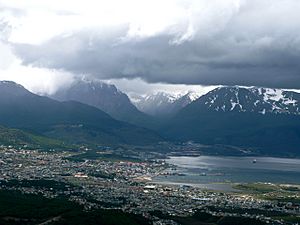
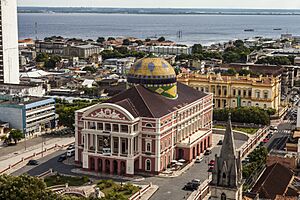
Member countries can have special "free trade zones." These are areas where goods are treated differently from other parts of the country. This means they might have different taxes or rules. For example, products from these zones might get special tax treatment when traded within Mercosur.
Products coming from outside Mercosur are usually taxed highly. This helps local companies compete with big international businesses.
Mercosur agreed that any free trade zones already operating in August 1994 could continue as normal. This means new, highly privileged free trade zones cannot be created. The special free trade zones in Manaus, Brazil, and Tierra del Fuego, Argentina, were allowed to continue operating until 2013 because of their unique locations.
Protecting Investments

Mercosur countries believe that protecting investments is important for economic cooperation. In 1994, Argentina, Uruguay, Paraguay, and Brazil signed the Colonia Protocol. This agreement says that investments made by people or companies from one Mercosur country in another Mercosur country will be treated fairly. They should get the same good treatment as local investors or investors from non-member countries.
Who is an Investor?
An investor can be:
- A person who is a citizen or lives permanently in a member country.
- A company created and based in a member country.
- A company in the country where the investment is made, but controlled by a person or company from another member country.
What Counts as an Investment?
Investments include all kinds of valuable things like:
- Property (buildings, land).
- Shares in companies.
- Money and financial rights.
- Intellectual property (like patents and trademarks).
- Rights to explore natural resources.
Freedom to Invest
The country receiving the investment cannot unfairly limit an investor's freedom to manage, use, or sell their investments. However, countries don't have to give special tax benefits that come from other international agreements.
Exceptions to Investment Rules
Some economic areas are exceptions where these new investment rules might not apply right away. For example:
- Argentina: Ownership of land near borders, air transport, nuclear power, mining, insurance, and fishing.
- Brazil: Mining, use of water energy, healthcare, TV and radio, buying rural land, financial services, and shipping.
- Paraguay: Land near borders, communications, transport, electricity, water, phone services, oil and gas exploration, and postal services.
- Uruguay: Electricity, oil, basic chemicals, atomic energy, mining, financial services, railways, and telecommunications.
Fair Compensation for Property

Mercosur countries agreed not to take over (nationalize or expropriate) investments from other member countries unless it's for a public need. If this happens, it must be done fairly and legally. The investor must receive fair and effective payment for their investment, based on its real value at the time it was taken. This payment will also include interest until it's paid.
Easy Money Transfers
Investors from member countries can freely transfer their investments and any money they earn. These transfers can be made in any currency that can be easily exchanged, using the current exchange rate. Member countries cannot stop these transfers.
Education and Integration

Education is seen as very important for regional integration. Mercosur countries agree that primary and junior high school courses (not technical ones) are considered equal across all member nations. This means if you start school in one Mercosur country, your studies will be recognized if you move to another.
If you don't finish your studies in one country, you can continue them in another. A special technical group helps make sure that school credits are recognized across all member nations. This group includes education officials from each country and meets regularly to solve any issues.
If there are disagreements about education rules, countries first try to solve them through talks. If that doesn't work, they use Mercosur's official dispute resolution system.
Mercosur's Future

Some people in South America see Mercosur as a way to combine resources and stand strong against other big economic powers like the North American Free Trade Agreement (NAFTA) and the European Union. Mercosur could also prevent the need for a larger Free Trade Area of the Americas (FTAA). In 2005, more than half of Mercosur countries rejected the FTAA idea.
Mercosur faced challenges when Argentina's economy struggled in 2001. There have also been disagreements about trade policies between member countries. Creating a common currency for Mercosur still has many obstacles.
In 2004, Mercosur signed an agreement with the Andean Community of Nations (CAN), another trade group. They plan to work towards integrating all of South America. Bolivia, which is part of both groups, is seen as a key country for connecting the Andean nations with the rest of South America.
Mercosur has a population of over 270 million people. The combined economic output of its full members is huge, making Mercosur the fifth-largest economy in the world. It's also the fourth-largest trading group after the European Union.
Not everyone agrees on how well Mercosur works. Chile, for example, has preferred to make its own trade deals with other countries. Some politicians in Uruguay have also suggested doing the same.
Trade Deals with Other Countries
Mercosur has made trade agreements with other countries and groups.
- In 2005, the Andean Community gained Argentina, Brazil, Paraguay, and Uruguay as associate members. This was a reciprocal move, as Mercosur had already given associate membership to all Andean Community nations.
- Mercosur signed free trade agreements with Israel in 2007, Egypt in 2010, the State of Palestine in 2011, and Lebanon in 2014.
- In 2016, leaders from Brazil and Argentina pushed for a free trade agreement between Mercosur and the European Union. In June 2019, this agreement was confirmed, opening up trade between the two blocs. However, it still needs to be fully approved.
- In November 2023, Mercosur and Singapore finished a free trade agreement. A deal with the EFTA is also being worked on.
See also
 In Spanish: Mercosur para niños
In Spanish: Mercosur para niños
- Citizenship of the Mercosur
- Andean Community
- Bolivarian Alliance for the Americas
- Central American Common Market
- Community of Latin American and Caribbean States
- Free Trade Area of the Americas
- Gaucho (currency)
- Pacific Alliance
- Union of South American Nations (UNASUR)
- Road Network of the MERCOSUR
- List of country groupings
- List of multilateral free-trade agreements
- Rules of Origin
- Free-trade area
- Market access
- Copa Mercosur



